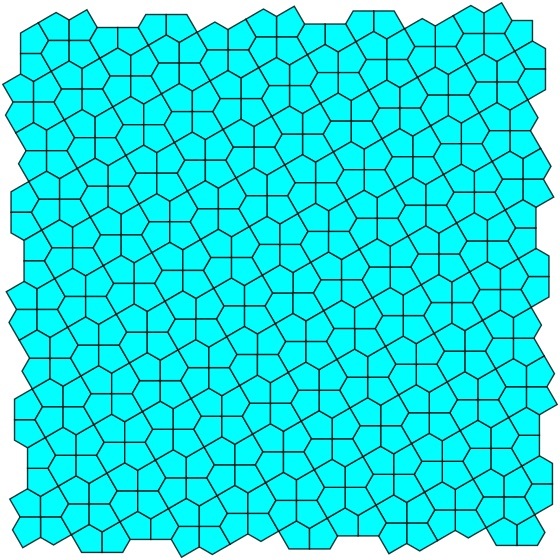Tiling Problem

We say that a figure 'tiles the plane' if the whole Euclidean plane may be covered by non-overlapping congruent copies of that figure.
What is the necessary and sufficient condition for a polygon in general to tile the plane?
Do provide a rigorous combinatorial proof for your claim.
No vote yet
1 vote
Easy Math Editor
This discussion board is a place to discuss our Daily Challenges and the math and science related to those challenges. Explanations are more than just a solution — they should explain the steps and thinking strategies that you used to obtain the solution. Comments should further the discussion of math and science.
When posting on Brilliant:
*italics*or_italics_**bold**or__bold__paragraph 1
paragraph 2
[example link](https://brilliant.org)> This is a quote# I indented these lines # 4 spaces, and now they show # up as a code block. print "hello world"\(...\)or\[...\]to ensure proper formatting.2 \times 32^{34}a_{i-1}\frac{2}{3}\sqrt{2}\sum_{i=1}^3\sin \theta\boxed{123}Comments
What I'm sure is that any form of triangle and quadrilateral is always able to tile a plane. Do someone has any proof that hexagon also always tile a plane AND none of the n-gon for n>=7 are able to tile a plane?
Log in to reply
If you are referring to regular polygons, then it is easy to show that tiling can only occur for n=3,4,6.
If you are referring to not-necessarily regular polygons, then there exist many counter-examples for n≥7. For example, MC Escher art. The T-tetramino and S-tetramino are simple shapes with 8 edges, that easily tile the plane.
I would likely disagree with your claim that "any quadrilateral / hexagon will always tile the plane". The easiest examples I can think of are V-shaped (with distinct slopes). I agree that "any triangle will always tile the plane", with the parallelogram proof that you stated.
Log in to reply
By the way, I re-read an article and it actually says 3 hexagons. So sorry for that. Also, I forgot to refer it as convex polygons, and sorry too for that. Well, sure, I agree with you, just that I have a proof for n = 3 and 4 but it's in a photo and I don't know how can I send it to here directly...
The concept cof tetranimoes from murderous maths
Proof for your "sure" claim, that any form of triangle and quadrilateral tile the plane ?
Log in to reply
No. I can prove both myself, but the problem is (nevermind the hexagon... I have re-read an article that says there's 3 of it) I need a proof that it's impossible for any n-gon to tile an Euclidean plane for every n>=7. Triangles are easy solution, quadrilateral: a little bit harder
Log in to reply
Let us know the proof that any quadrilateral can tile the plane.
Log in to reply
Alright.
2 triangles in a right positioning obviously make a parralelogram, which obviously tile a plane thanks to each pair of opposite side being parallel. OR do I need to prove that 2 congruent triangle are always able to form a parallelogram???
For quadrilateral, I guess I need to draw it... but the point is to use one of it in an oriented angle but use the other one by rotating it 180 degrees.
Log in to reply
Log in to reply
An example of such photo? Also, why can't we upload a photo here?
Ooo... but that's exactly what I meant. :) and I guess I'll just google the picture of a convex quadrilateral tiling a plane (but yes I proved myself that it always works...)
@Daniel Liu @Calvin Lin @Trevor Arashiro @Kishlaya Jaiswal @Agnishom Chattopadhyay
Log in to reply
Planar tiling isn't easy to deal with. There isn't a simple classification of such polygons. You can look at the wallpaper group, and try to determine certain conditions.